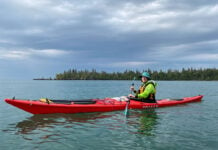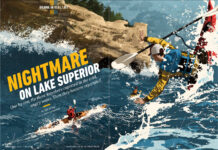As summer gets closer and more boats are hitting the water, it is important for everyone on the water to be aware of others sharing the waterway. The United States Coast Guard has issued Marine Safety Alert 04-17, a shared waterway alert.
“This Safety Alert reminds all operators of powerdriven, sail, and human propelled vessels of the importance of maintaining a sharp look-out while on a shared waterway and recommends that all recreational boaters carry a DSC-VHF marine radio in order to communicate with other vessels.”
The safety alert arose from a recent accident involving a passenger ferry and a group of kayakers on a busy metropolitan waterway. According to the alert “The incident occurred during late afternoon while the sun was low on the horizon with an angle of about 15 degrees and the ferry was heading westerly into the sun’s glare.
The ferry had just begun its voyage and was operating at about 20 knots across the waterway while a group of kayakers was ahead of the ferry and heading south. The low angle of the sun created significant glare on the water, obstructing the ferry operator’s view of the kayakers who were within the reflected light.
The kayakers did not have a DSC-VHF marine radio with them and they were unable to hail the ferry. The ferry subsequently collided with multiple kayaks resulting in two serious injuries.”
In order to safely share the waterways, you must have a good working knowledge of the Navigation Rules before entering the waterway. These rules include Steering and Sailing Rules, Conduct of Vessels in Sight of One Another, and Conduct of Vessels in Restricted Visibility.

You must also understand proper nautical lighting and shapes, as well as the the sound and light signals that may be encountered in order to take appropriate actions to prevent collisions.
According to the Safety Alert, The Coast Guard also strongly recommends “that all paddlesport enthusiasts participate in boating safety education as well as taking paddlecraft specific skills training. Additionally, the following best practices should be considered every time before going out on the water:
- Always wear a Coast Guard approved life jacket
- Make yourself be seen (bright / contrasting clothing)
- Carry a sound producing device such as a whistle
- Carry a DCS-VHF radio • Know your paddling limits
- Know the area where you will be operating
- Avoid paddling in main channels of busy waterways when possible
- Dress appropriately for the water temperature and forecasted weather
- Don’t paddle alone
- Tell a friend where you are going and when you will return – file a float plan.
- If you plan to be out after dark, you will be required to exhibit an all-round light or have a flashlight readily available
- Don’t drink alcohol and operate a boat or paddlecraft”
Online information on Shared Waterways is available at TheSafeHarbors.us








